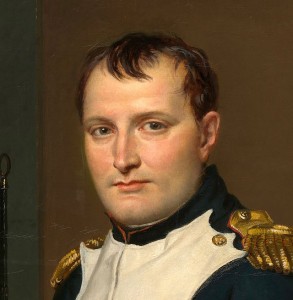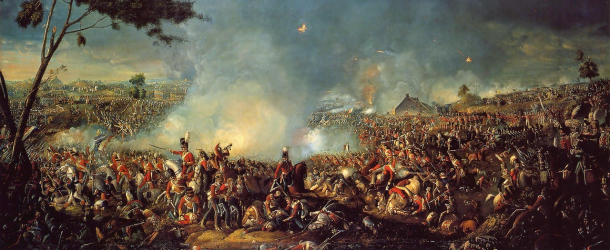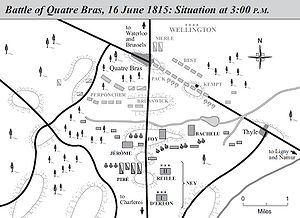By Paul D Fish DVM
 On April 6, 1814 Napoleon was forced to abdicate his thrown and go into exile on the island of Elba, near his birthplace in Corsica. He remained there for almost a year. Then on the evening of February 26, 1815, with a small band of loyal followers he boarded a ship that was to take him to the mainland and into history for a final showdown with the Allied Powers.
On April 6, 1814 Napoleon was forced to abdicate his thrown and go into exile on the island of Elba, near his birthplace in Corsica. He remained there for almost a year. Then on the evening of February 26, 1815, with a small band of loyal followers he boarded a ship that was to take him to the mainland and into history for a final showdown with the Allied Powers.
The representatives of the victorious Allies were at this time meeting in Vienna squabbling over how to divide up his Empire. But within a few weeks Napoleon was back in Paris with an army and the King, Louis XVIII, was gone. In a matter of 4 months without a shot being fired the French Emperor had an army of 600,000 men at his command. While in the lands surrounding France the Allies had raised 750,000.
Napoleon knew that he could not defeat all of these Allies forces at one time and so he came up with a plan to fight and defeat smaller portions of them individually.
The first of the great battles was to be in Belgium. The Allies had two armies there; the British lead coalitions under the command of Field Marshal Wellington and the Prussian army under Field Marshal Blucher. The strengths of these armies were as follows, the French had 122,600 men, Prussians 130,200 and Anglo-Allied 112,000. Napoleon knew that he could not get into the rear of either of his opponents due to the geography of the area. So he planned to attack the Prussian forces first and drive them off. He could then take on the Anglo-Allied force without the fear of the Prussians intervening. Thus, his basic scheme for the campaign was the Strategy of the Central Position. It had worked well for him in the past, as in Italy in 1796.
On the morning of June 15, 1815 the French army began to cross the Sambre River entering Belgium. Unfortunately for him, things did not go as planned.
First, orders were given to begin the advance at dawn. On the French left, II Corps under General Reille was delayed by the resistance of elements of 2nd Brigade of the Prussian I Corps. A short but hot fight delayed the crossing until 1000 hours. Then the main body of the French forces became muddled when newly promoted Marshal N. Soult sent only one rider with his instructions to General de Division Dominique Vandamme’s III Corps. The courier got lost and when he finally arrived at the headquarters, Vandamme was not present. A new courier had to be sent to find the General and also got lost before falling from his horse and breaking his leg. As a result, when the units of Vandamme’s Corps finally did move forward they became entangled with the men of General Lobau’s VI Corps. The III Corps was supposed to follow VI Corps across the bridge at Charleroi and support I Cavalry Corps by 1100 hours. Due to the confusion, however, this did not happen. The French cavalrymen were left unsupported as they battled the 1st and 2nd Brigades of Zeithen’s I Corps. Napoleon, myself, had to save the situation by committing the Old Guard engineers and marines to clear the bridge over the Sambre. But by noon the French has taken the town and begun to spread out north of Charleroi.
General de Division Gerard’s IV Corps was originally intended to cross at Charleroi also, but was sent new orders to move to Chatelet. There were also delays in moving to this new location for a river crossing. To complicate the situation further, General de Division Louis Bourmont, of the 14th Division, deserted to the enemy with his staff and proceeded to reveal all of Napoleon’s plans to Blucher. General Blucher then ordered Zeithen’s I Corps to pull back from the frontier, while the rest of the Prussian army concentrated near Sombreffe. This, however, was a serious error on the part of Blucher, as he was too far forward and could have easily been cut off by the French.
Napoleon then brought the Young Guard and Vandamme’s III Corps to aid the cavalrymen of Pajol’s I Cavalry Corps and Exelman’s II Cavalry Corps. Zeithen’s 2nd Brigade retreated to Solielmont, where it was bolstered by 3rd and 4th Brigades. Napoleon was ready for a fight, but Zeithen refused and moved back to Fleurus. In addition, Zeithen’s 1st Brigade had moved to Gosselies on the road to Quatre Bras.
Wellington was not idly during this time, however. He was making his own mistakes. Having learned of the French activity, he put his troops on alert. Wellington was convinced that the attack would come from the west in an attempt to cut him off from his base on the coast. He ordered I Corps and II Corps to move to the west and southwest of Brussels toward Mons. Basically, he was moving too far away from Blucher and would not have been able to offer him support in case of a major battle. Fortunately for the Allies, Wellington was saved by Major General Jean de Constant-Rebecque, the Prince of Orange’s chief of staff. Rebecque was appalled when he read the orders to move west. He knew that the French were advancing from the south of Brussels. He spoke with Lieutenant General de Perponcher-Sedlnitzky, who commanded the 2nd Dutch-Belgian Infantry Division. They, therefore, decided to send Prince Bernard of Saxe-Weimar’s Brigade to probe southwards from the crossroads village of Quarter Bras.
At this time the French Marshal Michel Ney was in command of the left wing of Napoleon’s army, while newly promoted Marshal Emmanuel Grouchy had the right. Ney sent Baron Pire’s 2nd Cavalry Division and General Charles Lefebvre-Desnouettes’ Guard Light Cavalry Division north along the Charleroi-Brussels road. This road was being defended by Steinmetz’s 1st Brigade. Although, the Prussians had more men at the time, Steinmetz felt it best to withdraw before larger French forces arrived. This allowed the French open access to the road to Quartre Bras. At this point, Ney made two serious errors. First, he didn’t pursue Steinmetz with any large force or speed. Only the small 7th Division of General Girard was sent in pursuit. Secondly, Ney waited for d’Erlon’s I Corps to arrive on the scene. He did, however, send Pire and Lefebvre-Desnouettes northward to reconnoiter the road to Brussels.
At about 1900 these troops ran into the 2nd battalion of the 2nd Nassau regiment defending Quartre Bras itself. The Dutchmen then put up a strong front with heavy firepower from their 8 cannons, while the French halted and waited for further orders.
After Ney finally told them to proceed with caution, the Dutch fell back 3 kilometers, where they were joined by Saxe-Weimar’s Brigade. These were the men that had been dispatched by Constant-Rebecque against Wellington’s orders. Ney had missed his chance to take the road into Brussels with very little effort. He would come to regret this in the morning.
The next day, June 16, two battles took place. The French forces were divided between the fight at Quartre Bras against the Dutch-Belgians and British. The other half of the French engaged the Prussian army at Ligny. The French managed to obtain a marginal victory at Ligny by pushing the Prussians out of the town. Although, the Prussian forces retreated in good order to Warve, which kept them within a few kilometers of Waterloo, while the French only managed to finished the day at Quartre Bras nearly in the same location they had started from.
The combined British and Allied forces then moved toward Brussels, to the town of Waterloo as they needed to stay in touch with the Prussian who had also retreated. On June 18, 1815 the giant armies would meet once again, at Waterloo, Warve and Plancenoit.











